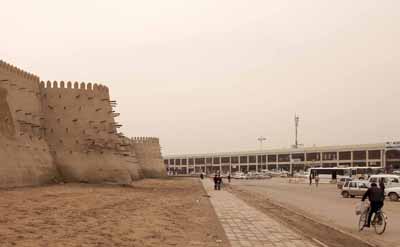The dating and location of the various city walls which have surrounded Bukhara for the last 1500 years or so is an extremely complicated subject which has flummoxed many a determined investigator. Original sources are scarce, contradictory, and confusing, but the ever-resolute W. Barthold has waded into the morass and emerged with a short synopsis, although even this hallowed Orientalist at times displays a lamentable lack of cogency. Other secondary sources, including guidebooks to the city right down to the present day, only succeed in piling on more layers of obstrufication.
We might assume that the city was protected by walls from the attacks of nomadic raiders and bandits as far back as the early Sogdian period, starting around the beginning of the Christian Era, and that the city was surrounded by walls by the time of the Arab invasions in the eighth century. We do known that the old pre-Samanid town, dating back as far as the time of Abu Muslim in the first half of the eighth century, had both a wall around the rabad, or outer town, and an inner wall around the Shahristan, or inner town. The rabat wall had eleven gates, but no accurate information is given about its length. These double walls was rebuilt by the Qarakhanid Arslan Khan Muhammed in first half of the twelfth century, again by Qilich Tamghach Khan in 1165, and finally by the Khorezmshah at the beginning of the thirteen century. The walls repaired or restored by the Khorezmshah were the ones encountered by Chingis Khan when He Arrived At The City In 1220.
Yet the available accounts of Chingis’s investment of the city mention his troops besieging only one wall. This must be assumed to the Shahristan Wall. Perhaps the Rabad Wall was only intended to keep out bandits and small raiding parties and not a large and determined army like Chingis’s. Also, manning the outer wall might have spread the available troops dangerously thin. Thus the military commanders of the city may well have decided to cede the outer wall to Chingis and set up a defensive ring on the shorter inner wall, which was also presumably stronger and higher than the outer wall.
In the event, however, the Shahristan Wall was easily stormed by Chingis Khan’s army and was later completely destroyed. According to local historians not a trace of it remains to the present day. We do know however, that the vast cemetery (now Kirov Park) where the Ismail Samani Mausoleum was built was outside the Shahristan Wall, and inside the Rabat Wall. The Shahristan Wall must have run somewhere, therefore, somewhere between the Ark, or inner Fortress, and the Samanid Mausoleum.
The city walls, now partly restored, currently visible just beyond the Samanid Mausoleum in Kirov Park, were built by the Shaybanid Dynasty in the sixteenth century and probably rebuilt and repaired in the eighteenth century. How closely this Shaybanid Wall follows the old pre-Chingis Rabad Wall is uncertain. In any case, these partially restored walls may give a general idea of the appearance of the walls Chingis faced when he arrived on the outskirts of the city in 1220.
Partially restored gate in the Shaybinid Wall
Shaybinid Wall
Shaybinid Wall
Another restored gate in the Shaybinid Wall
Shaybinid Wall
Shaybinid Wall
Modern Bukhara: Shaybinid Wall to the left; shopping center to the right











A shopping center next to a historical site like this?! Sounds like Northern Virginia. Oh, let's put a Walmart on the old Battlefield. Great idea.
ReplyDeleteThe shopping center seems like such an architectural aberration. Great photos!
ReplyDelete-a mes
I may have exaggerated by calling this a “shopping center”. It is more of a helter-skelter bazaar and ragtag flea market, with everything from car parts to washing machines and sides of beef for sale. There was no Starbucks as far as I could tell, although by the time I got there I certainly could have used a couple of double expressos and a latte chaser.
ReplyDelete